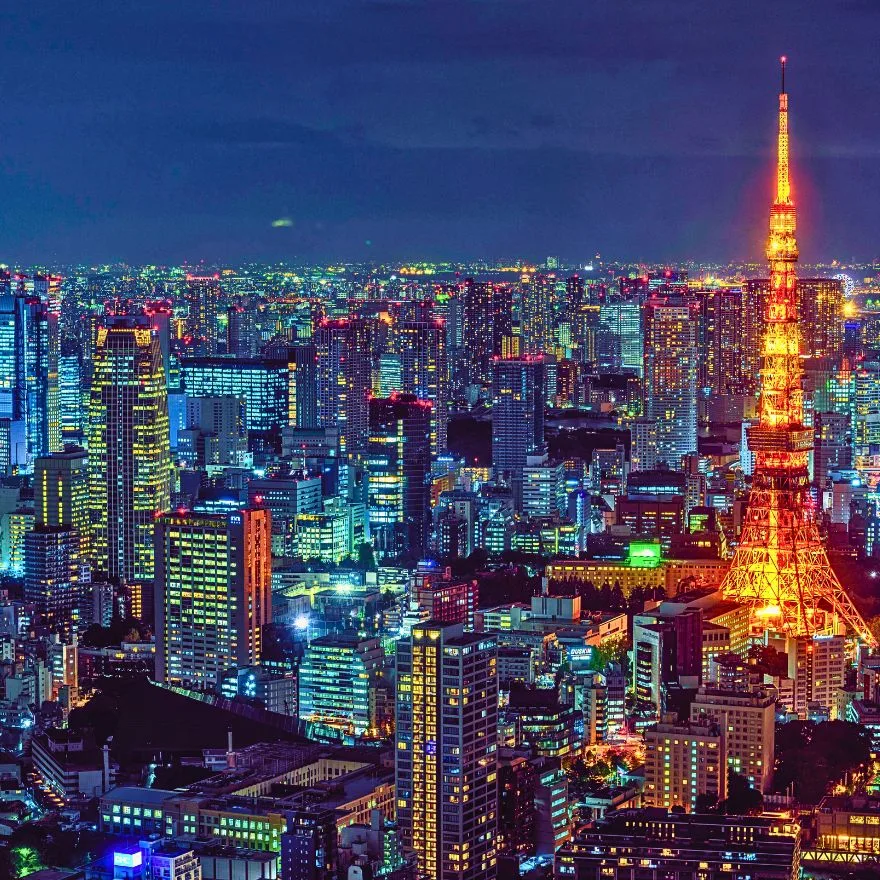
There are cities that move to the steady rhythm of time, and then there is Tokyo—a city that beats like a thousand drums at once, yet whispers with the grace of a soft koto melody. To walk through Tokyo is to wander in a living poem, where ancient shrines bow gently beside neon-lit towers, where ramen steam rises like incense, and where history and future clasp hands without hesitation. Tokyo is not merely a destination—it is an immersion, a pulse, a surrender.
This journey through Tokyo will guide you across ten unmissable places, introduce you to dishes that define its culinary soul, share with you fragments of its layered history, and offer tips so your path through this luminous metropolis may be as smooth as silk.
Best places to visit in Tokyo
1. Sensō-ji Temple – Where Time First Breathes
At the heart of Asakusa, the oldest temple in Tokyo rises with grace and majesty: Sensō-ji. Founded in 628 AD, this Buddhist sanctuary has endured fire, war, and the storms of centuries. The approach begins at Kaminarimon (Thunder Gate), its crimson lantern glowing like an eternal flame, guiding pilgrims and wanderers alike.
Walking through Nakamise-dori, a street lined with traditional shops selling sweets, fans, and trinkets, you are embraced by scents of roasted chestnuts and ningyo-yaki cakes. Sensō-ji itself glows in vermilion and gold, its incense curling skyward as if carrying prayers to the heavens. Here, Tokyo bows to its roots, reminding travelers that beneath the rush of trains and skyscrapers, a quiet soul beats on.
2. Meiji Shrine – A Forested Reverie
Step into the sacred forest of Meiji Jingu, and the city dissolves into a dream of green silence. This Shinto shrine, dedicated to Emperor Meiji and Empress Shoken, is surrounded by more than 100,000 trees, planted by citizens from across Japan a century ago. The wide gravel path crunches softly beneath your steps, lined with towering torii gates that stand as silent guardians.
At the shrine itself, wooden ema (prayer plaques) hang like whispers of countless hearts. Weddings often unfold here, with brides in white kimono moving like blossoms across stone. The shrine is not merely a place of worship—it is Tokyo’s breath, an oasis of serenity, a reminder that even in a city of speed, reverence has its rightful space.
3. Shibuya Crossing – The Pulse of the World
If Tokyo had a heartbeat, it would echo at Shibuya Crossing, the busiest pedestrian scramble on earth. Thousands of people surge forward with each green light—students, businessmen, artists, tourists—merging and parting in a choreography that feels chaotic yet strangely beautiful.
Above, neon billboards blaze with colors, while the iconic Hachikō statue, the loyal dog who waited for his master each day, stands nearby as a testament to devotion. Watching the scramble from a café window, you realize that this chaos is not disorder—it is harmony in motion, the essence of Tokyo itself.
4. Tsukiji Outer Market – A Feast of the Sea
Although the famous tuna auctions have moved to Toyosu, the Tsukiji Outer Market remains alive with energy. Narrow lanes brim with stalls offering everything from sushi to grilled scallops, tamagoyaki (sweet omelet), and matcha desserts. The scent of soy, the hiss of grills, the chatter of vendors—it is a symphony of flavor and commerce.
Here, food is not just sustenance; it is art. Sit down for a bowl of donburi topped with the freshest sashimi, and taste the Pacific in its purest form. Tsukiji is a reminder that Tokyo’s heart is not only concrete and steel, but also rice, fish, and the sea.
5. The Imperial Palace – A Quiet Majesty
In the center of Tokyo lies a sanctuary of history and dignity: the Imperial Palace, home of Japan’s Emperor. Surrounded by moats, stone walls, and gardens, the palace grounds whisper of the Edo Castle that once stood here, a fortress of shoguns who ruled from the 17th century.
The East Gardens are open to the public, where cherry blossoms and koi ponds bring peace to all who wander through. The iconic Nijubashi Bridge, often photographed with its graceful arches, is a vision of timeless elegance. To stand here is to feel Tokyo’s continuity—the throne of emperors still rests in the very heart of this modern city.
6. Ueno Park – Blossoms, Museums, and Memory
When spring comes, Ueno Park becomes a festival of petals. Thousands of cherry trees paint the sky pink, while families gather for picnics beneath their falling blossoms. Yet Ueno is not only for spring. It holds treasures year-round: the Tokyo National Museum, the National Museum of Nature and Science, and the Ueno Zoo.
History breathes here too. Ueno was once the site of a fierce battle during the Boshin War, where samurai fought to preserve the shogunate. Today, the park is a tapestry of culture, memory, and joy. In every corner, art and history meet play and laughter.
7. Akihabara – Electric Dreams
If Shibuya is Tokyo’s heart, then Akihabara is its electric imagination. Once a hub for post-war black markets, today it gleams as the mecca of anime, manga, and electronics. Towering shops overflow with gadgets, figurines, and games, while maid cafés welcome visitors with playful theatrics.
Akihabara is a pilgrimage for dreamers. It is where fantasy and reality blur, where the future glimmers on every screen. Even if you are not a gamer or collector, the energy here is irresistible—Tokyo’s neon creativity distilled into a single district.
8. Tokyo Skytree – A Tower of Light
Rising at 634 meters, the Tokyo Skytree is a modern marvel, the tallest structure in Japan. From its observation decks, the city stretches endlessly, a sea of buildings with Mount Fuji sometimes visible in the distance like a ghostly guardian.
At night, the Skytree glows in soft hues, reflecting in the nearby Sumida River. Beneath it, Solamachi mall bustles with shops, restaurants, and an aquarium. The tower is not just a feat of engineering; it is Tokyo’s lighthouse, a symbol of its reach for the heavens.
9. Odaiba – A Futuristic Playground
Floating in Tokyo Bay lies Odaiba, a man-made island where innovation and leisure intertwine. Here stands a replica of the Statue of Liberty, the futuristic Fuji TV building, and shopping malls filled with entertainment.
TeamLab Borderless, a digital art museum, creates dreamscapes where light and color flow endlessly around you, dissolving the line between visitor and artwork. Outside, the Rainbow Bridge lights up the night, arching like a promise across the water. Odaiba feels like a tomorrow that has already arrived.
10. Yanaka – The Soul of Old Tokyo
Amidst the rush of modernity, Yanaka whispers with nostalgia. This neighborhood, spared from wartime destruction, still holds wooden houses, narrow alleys, and old temples. Cats wander freely, shops sell handmade goods, and the air feels slower, softer.
Yanaka Cemetery, shaded by cherry trees, is both peaceful and poignant, holding centuries of stories within its stones. To walk here is to glimpse Tokyo as it once was—a city of intimacy, humanity, and quiet dignity.
The Flavors of Tokyo – A Culinary Poem
No journey is complete without tasting the soul of its kitchens. In Tokyo, every meal is a story:
- Ramen – Slurp a steaming bowl in Shinjuku or Ikebukuro, where pork broth, soy, or miso embrace noodles with warmth.
- Sushi – From Tsukiji’s freshest slices to Michelin-starred counters, sushi is Tokyo’s crown jewel.
- Okonomiyaki – A savory pancake layered with cabbage, pork, and sauces, cooked sizzling before you.
- Tempura – Golden, crisp, and delicate, tempura turns shrimp and vegetables into edible poetry.
- Wagashi – Traditional sweets shaped like flowers, often served with matcha tea.
Every dish here tells of centuries of craftsmanship, respect for ingredients, and a reverence for balance.
A Brief History of Tokyo – From Edo to Empire
Tokyo was not always Tokyo. Once, it was Edo, a modest fishing village that rose to power when Tokugawa Ieyasu established his shogunate here in 1603. Edo grew into one of the world’s largest cities by the 18th century, alive with kabuki theaters, floating teahouses, and merchants.
After the Meiji Restoration in 1868, the Emperor moved the capital from Kyoto to Edo, renaming it Tokyo—Eastern Capital. From then, Tokyo became the stage where tradition met modernization, where bullet trains would one day hum past wooden shrines, and where resilience would rebuild after fires, earthquakes, and war. Today, Tokyo stands as a city that remembers and reinvents, endlessly.
The Best Season to Visit
Tokyo shifts moods with the seasons:
- Spring (March–May): Cherry blossoms bloom, painting the city in soft pink. Hanami (flower-viewing) picnics fill parks with joy.
- Autumn (September–November): Crimson maples and golden ginkgo trees make the city glow. The air is crisp, perfect for long walks.
- Winter (December–February): Illuminations brighten the nights, Mount Fuji appears more clearly, and hot bowls of ramen warm the soul.
- Summer (June–August): Humid but lively, filled with fireworks festivals and yukata-clad celebrations.
For many, spring and autumn are the most enchanting, when weather and beauty dance in harmony.
Travel Tips for a Smooth Journey
- Transportation: Get a Suica or Pasmo card to glide easily through trains and subways. Tokyo’s transport is efficient but vast—apps like Google Maps or HyperDia help immensely.
- Cash & Cards: While Japan embraces digital payments more than before, many shops and restaurants still prefer cash. ATMs at 7-Eleven are traveler-friendly.
- Language: Many signs are bilingual, but learning a few Japanese phrases (like arigatou – thank you) opens hearts.
- Etiquette: Respect is key—queue patiently, speak softly on trains, and remove shoes when entering traditional spaces.
- Connectivity: A pocket Wi-Fi or local SIM is essential for navigating and staying connected.
A Smooth Ride Through the City – Discover Cars
Tokyo invites exploration not only within but also beyond its borders—to Nikko’s shrines, Hakone’s hot springs, or the serene beauty of Mount Fuji. Renting a car makes such adventures effortless. With DiscoverCars, you can find affordable, reliable rentals and set your own rhythm of travel. Whether it’s winding mountain roads or coastal drives, freedom awaits behind the wheel.
Always Connected – Drimsim for Travelers
In a city where neon signs blaze with information and trains crisscross like veins, staying connected is essential. That’s where Drimsim comes in—a universal SIM card for travelers, giving you reliable data without borders. With Drimsim, your map, your words, and your world remain in your pocket, wherever Tokyo’s journey may carry you.
The Gift of Tokyo
Tokyo is not a city you simply visit. It is a city that teaches you to see differently—to embrace the clash of contrasts, to find serenity in speed, to bow to history while racing toward tomorrow. In its shrines and skyscrapers, sushi counters and neon lanes, Tokyo reveals a truth: that beauty is not in choosing between past and future, but in letting both flow together.
When you leave Tokyo, it will not leave you. It will linger in your senses—the taste of miso broth, the glow of lanterns in Asakusa, the hum of trains at dusk. Tokyo is not just a place on a map; it is a rhythm that once heard, never fades.


